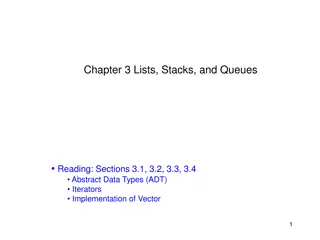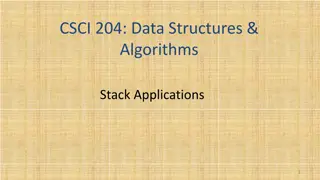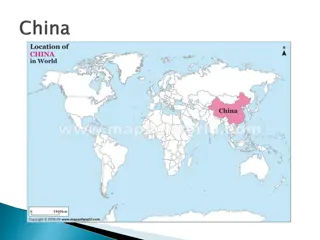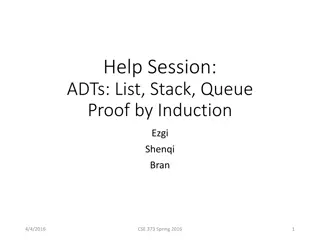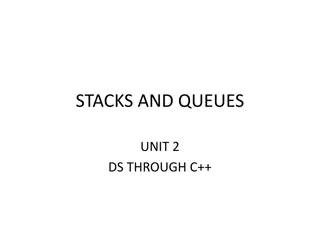
Understanding Genetic Population Analysis Tools: STACKS & Arlequin
Explore the capabilities of STACKS and Arlequin in population genetics analysis, including generating summary statistics, computing genetic measures, and assessing population differentiation. Learn about Fst values and how they indicate genetic diversity levels between populations. Discover the versatile functionalities of these software programs for analyzing genetic data sets using various methods and statistical tests.
Download Presentation

Please find below an Image/Link to download the presentation.
The content on the website is provided AS IS for your information and personal use only. It may not be sold, licensed, or shared on other websites without obtaining consent from the author. If you encounter any issues during the download, it is possible that the publisher has removed the file from their server.
You are allowed to download the files provided on this website for personal or commercial use, subject to the condition that they are used lawfully. All files are the property of their respective owners.
The content on the website is provided AS IS for your information and personal use only. It may not be sold, licensed, or shared on other websites without obtaining consent from the author.
E N D
Presentation Transcript
STACKS & ARLEQUIN Zhou jingtong
STACKS Stacks provides tools to generate summary statistics and to compute population genetic measures such as FIS and within populations and FST between populations, allowing for genome scans. 1.building genetic maps 2.conducting population genomics 3.conducting phylogeography The populations program will analyze a population of individual samples computing a number of population genetics statistics as well as exporting a variety of standard output formats. And compare all populations pairwise to compute FST.
F Fst st Fstis develop from F statistics, reflecting the level of heterozygosity of population alleles, and used to measure the degree of population differentiation. = Average heterozygosity in composite population Average heterozygosity among subpopulations H H 1 , 0 T S st F F st H T If Fst in 0 ~ 0.05 very small, which can be ignored If Fst in 0.05 ~ 0.15 0.05 ~ 0.15, means moderate genetic differentiation moderate genetic differentiation between populations. If Fst in 0.15 ~ 0.25 0.15 ~ 0.25, means large genetic differentiation large genetic differentiation between populations. If Fst > 0.25 > 0.25, means great genetic differentiation great genetic differentiation between populations. 0 ~ 0.05, means that the genetic differentiation between populations is can be ignored.
Program Options enable SNP and haplotype-based F statistics. path to a directory where to white the output files. (Required by -V; otherwise defaults to value of -P.) path to the directory containing the Stacks files. path to a population map populations -P dir [-O dir] [-M popmap] (filters) [--fstats] [-k [--sigma=150000] [--bootstrap [-N 100]]] (output formats) populations -V vcf -O dir [-M popmap] (filters) [--fstats] [-k [--sigma=150000] [--bootstrap [-N 100]]] (output formats) number of bootstrap resamplings to calculate (default 100). path to an input VCF file.
Result If Fst in 0 ~ 0.05 0 ~ 0.05, means that the genetic differentiation between populations is very small, which can be ignored can be ignored. If Fst in 0.05 ~ 0.15 0.05 ~ 0.15, means moderate genetic differentiation moderate genetic differentiation between populations. If Fst in 0.15 ~ 0.25 0.15 ~ 0.25, means large genetic differentiation large genetic differentiation between populations. If Fst > 0.25 > 0.25, means great genetic differentiation great genetic differentiation between populations.
Arlequin An Integrated Software for Population Genetics Data Analysis quite a large set of basic methods and statistical tests Purpose analyze several times the same data set from different perspectives data types are: DNA sequences arbitrary length Inter-population methods: AMOVA Hardy-Weinberg equilibrium RFLP data Microsatellite data Standard data Allele frequency data
AMOVA Different hierarchical Analyses of Molecular Variance to evaluate the amount of population genetic structure. This method can discuss whether there are corresponding genetic variations among different altitudes, different languages, and geographic groups.
1.AMOVA with haplotypic dataa sister chromatid A separate AMOVA can be performed for each locus separately. Population specific FST indices will be computed for all loci and for each locus separately Enter the number of permutations used to test the significance of covariance components and fixation indices. 1. project distance matrix 2. Compute distance matrix 3. Use conventional F-statistics
2.AMOVA with genotypic datauncommonly used Compared to haplotypic data, it becomes possible to compute the average inbreeding coefficient FIS with diploid genotypic data. Include the intra-individual covariance component of genetic diversity, and its associated inbreeding coefficients (FIS and FIT) Compute inbreeding coefficients (FIS) separately for each population and test it by permutation of gene copies between individuals within population. Include individual level
null hypothesis There are no differences among populations P-value<=0.05(violate)
Hardy-Weinberg equilibrium In an infinite mating population that mates with each other without mutation, migration and selection, gene frequency and genotype frequency will remain unchanged from generation to generation. One locus with 2 alleles at HWE: p2+ 2pq + q2= 1 Test of non-random association of alleles within diploid individuals. Separate tests are carried out at each locus.
The maximum number of alternative tables to explore The number of steps to perform before beginning to compare the alternative table probabilities to that of the observed table. Perform separate HWE test for each locus. Perform a HWE test at the haplotype level (if gametic phase is available). Perform both kinds of tests (if gametic phase is available)
null hypothesis Conform Hardy-Weinberg equilibrium P-value>0.05(Conform)


